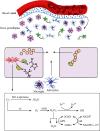The Gut Microbiota and Oxidative Stress in Autism Spectrum Disorders (ASD)
- PMID: 33062148
- PMCID: PMC7547345
- DOI: 10.1155/2020/8396708
The Gut Microbiota and Oxidative Stress in Autism Spectrum Disorders (ASD)
Abstract
Autism spectrum disorders (ASDs) are a kind of neurodevelopmental disorder with rapidly increasing morbidity. In recent years, many studies have proposed a possible link between ASD and multiple environmental as well as genetic risk factors; nevertheless, recent studies have still failed to identify the specific pathogenesis. An analysis of the literature showed that oxidative stress and redox imbalance caused by high levels of reactive oxygen species (ROS) are thought to be integral parts of ASD pathophysiology. On the one hand, this review aims to elucidate the communications between oxidative stress, as a risk factor, and ASD. As such, there is also evidence to suggest that early assessment and treatment of antioxidant status are likely to result in improved long-term prognosis by disturbing oxidative stress in the brain to avoid additional irreversible brain damage. Accordingly, we will also discuss the possibility of novel therapies regarding oxidative stress as a target according to recent literature. On the other hand, this review suggests a definite relationship between ASD and an unbalanced gastrointestinal tract (GIT) microbiota (i.e., GIT dysbiosis). A variety of studies have concluded that the intestinal microbiota influences many aspects of human health, including metabolism, the immune and nervous systems, and the mucosal barrier. Additionally, the oxidative stress and GIT dysfunction in autistic children have both been reported to be related to mitochondrial dysfunction. What is the connection between them? Moreover, specific changes in the GIT microbiota are clearly observed in most autistic children, and the related mechanisms and the connection among ASD, the GIT microbiota, and oxidative stress are also discussed, providing a theory and molecular strategies for clinical practice as well as further studies.
Copyright © 2020 Tingting Hu et al.
Conflict of interest statement
The authors declare no conflict of interest.
Figures




Similar articles
-
The Possible Role of the Microbiota-Gut-Brain-Axis in Autism Spectrum Disorder.Int J Mol Sci. 2019 Apr 29;20(9):2115. doi: 10.3390/ijms20092115. Int J Mol Sci. 2019. PMID: 31035684 Free PMC article. Review.
-
Oxidative Stress in Autism Spectrum Disorder.Mol Neurobiol. 2020 May;57(5):2314-2332. doi: 10.1007/s12035-019-01742-2. Epub 2020 Feb 5. Mol Neurobiol. 2020. PMID: 32026227 Review.
-
Gut-to-Brain Axis in Autism Spectrum Disorders: Central Role for the Microbiome.Int Rev Neurobiol. 2016;131:263-287. doi: 10.1016/bs.irn.2016.09.001. Epub 2016 Sep 30. Int Rev Neurobiol. 2016. PMID: 27793223 Review.
-
Impact of pesticides exposure during neurodevelopmental period on autism spectrum disorders - A focus on gut microbiota.Ecotoxicol Environ Saf. 2023 Jul 15;260:115079. doi: 10.1016/j.ecoenv.2023.115079. Epub 2023 May 30. Ecotoxicol Environ Saf. 2023. PMID: 37262968 Review.
-
Clinical and Molecular Characteristics of Mitochondrial Dysfunction in Autism Spectrum Disorder.Mol Diagn Ther. 2018 Oct;22(5):571-593. doi: 10.1007/s40291-018-0352-x. Mol Diagn Ther. 2018. PMID: 30039193 Free PMC article. Review.
Cited by
-
Metabolomic changes in children with autism.World J Clin Pediatr. 2024 Jun 9;13(2):92737. doi: 10.5409/wjcp.v13.i2.92737. eCollection 2024 Jun 9. World J Clin Pediatr. 2024. PMID: 38947988 Free PMC article.
-
Gut microbes in central nervous system development and related disorders.Front Immunol. 2024 Jan 26;14:1288256. doi: 10.3389/fimmu.2023.1288256. eCollection 2023. Front Immunol. 2024. PMID: 38343438 Free PMC article. Review.
-
Investigation of LncRNA PVT1 and MiR-21-5p Expression as Promising Novel Biomarkers for Autism Spectrum Disorder.J Mol Neurosci. 2023 Oct;73(9-10):865-873. doi: 10.1007/s12031-023-02161-8. Epub 2023 Oct 13. J Mol Neurosci. 2023. PMID: 37828403
-
Gut microbiota remodeling exacerbates neuroinflammation and cognitive dysfunction via the microbiota-gut-brain axis in prenatal VPA-exposed C57BL/6 mice offspring.Front Immunol. 2025 Aug 13;16:1633680. doi: 10.3389/fimmu.2025.1633680. eCollection 2025. Front Immunol. 2025. PMID: 40881681 Free PMC article.
-
Blood cadmium concentration and pulmonary function injury: potential mediating role of oxidative stress in chronic obstructive pulmonary disease patients.BMC Pulm Med. 2024 Sep 17;24(1):459. doi: 10.1186/s12890-024-03269-2. BMC Pulm Med. 2024. PMID: 39289625 Free PMC article.
References
-
- Wu C. Autism Research Institute. Report on the Development of China’s Autism Education and Rehabilitation Industry (in Chinese). II. Beijing: Huaxia Publishing House; 2017.
-
- Saad K., Abdel-rahman A. A., Elserogy Y. M., et al. Vitamin D status in autism spectrum disorders and the efficacy of vitamin D supplementation in autistic children. Nutritional Neuroscience. 2015;19(8):346–351. - PubMed
Publication types
MeSH terms
Substances
LinkOut - more resources
Full Text Sources
Medical
Research Materials

